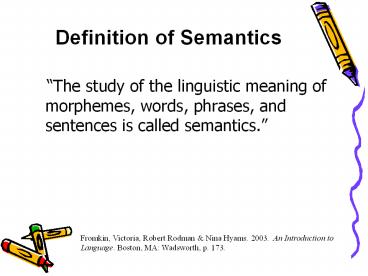Definition%20of%20Semantics - PowerPoint PPT Presentation
Title:
Definition%20of%20Semantics
Description:
Definition of Semantics The study of the linguistic meaning of morphemes, words, phrases, and sentences is called semantics. Fromkin, Victoria, Robert Rodman ... – PowerPoint PPT presentation
Number of Views:146
Avg rating:3.0/5.0
Title: Definition%20of%20Semantics
1
Definition of Semantics
- The study of the linguistic meaning of
morphemes, words, phrases, and sentences is
called semantics.
Fromkin, Victoria, Robert Rodman Nina Hyams.
2003. An Introduction to Language. Boston, MA
Wadsworth, p. 173.
2
Meaning
- Semantics
- Words Lexical Semantics
- Phrases Phrasal Semantics
- Sentences Sentential Semantics
- Pragmatics
- Discourse Pragmatics
- (Context)
Fromkin, Victoria, Robert Rodman Nina Hyams.
2003. An Introduction to Language. Boston, MA
Wadsworth, p. 173.
3
Basis for Understanding Speech
- Learning a language includes learning the
agreed-upon meanings of certain strings of sounds
and learning how to combine these meaningful
units into larger units that also convey
meaning. - All speakers of a language share a basic
vocabularythe sounds and meanings of morphemes
and words. - (My emphasis.)
Fromkin, Victoria, Robert Rodman Nina Hyams.
2003. An Introduction to Language. Boston, MA
Wadsworth, p. 173.
4
Mental Lexicon
- ? Pronunciation
- ? Meaning
- (including Semantic Properties)
- ? Relationship to other words
- ? Grammatical category
- ? How to use it in sentences.
- ? Potential collocations and idioms
- ? Spelling
5
Examples of Semantic Properties/Features
- ? person, woman, doctor, boy, engineer, baby
- human
- ? doe, lady, sister, mare, her
- female
- ? girl, actress, woman, aunt, wife, widow
- human, female
- ? child, baby, puppy, kitten
- animate, young
6
Speech Errors
- Intended Utterance
- Actual Utterance (Error)
- bridge of the nose
- bridge of the neck
- when my gums bled
- when my tongues bled
- he came too late
- he came too early
7
Speech Errors
- Mary was young
- Mary was early
- lady with the dachshund
- lady with the Volkswagen
- a horse of another color
- a horse of another race
- he has to pay her alimony
- he has to pay her rent
8
Chapter 5 Homework(pp. 222-223, 1)
- A. (a) and (b) are male
- (a) are human
- (b) are human (animals)
- B. (a) are count (countable)
- (b) are count (non-count)
- C. (a) are concrete
- (b) are concrete (abstract)
9
Chapter 5 Homework(pp. 222-223, 1)
- D. (a) and (b) are animate (plants)
- (a) are trees
- (b) are flowers
- E. (a) are written documents
- (b) are writing instruments
- F. (a) and (b) are movement
- (a) are done with body/ no
equipment - (b) are require equipment
10
Chapter 5 Homework(pp. 222-223, 1)
- G. (a) and (b) are speech (use language)
- (a) are ways to use speech
- (b) are manners of speech
- H. (a) and (b) are opposites
- (a) are complementary pairs
- (b) are gradable
- I. (a) and (b) are adjective
- (a) are NP is not necessarily an N
- (b) are NP is an example of N
11
Relationships between Words(-nyms)
- ? Different words (Heteronym)
- ? Same? word (Polysemy)
- ? Homonyms (Homophones)
- ? Homographs
- ? Heteronyms
12
Chapter 5, Homework(p. 224, 2)
- a. bank
- b. kind
- c. sole
- d. drill / boring
- e. deed
- f. ruler
- g. can
- h. shop
- i. every a
- j. a
13
Relationships between Words(Semantic)
- ? Synonyms
- ? Antonyms
- ? Hyponyms
- ? Metonyms
- ? Retronyms
14
Types of Antonyms
- Gradable Pairs
- more of A is less of B
- big/small hot/cold
- Complementary Pairs
- A not B B not A
- alive/dead awake/asleep
- (Relative scale small elephant/big mouse)
- Relational Pairs
- If X Ys A, then Y Xs B
- teacher/student give/receive
15
Proper Names
- ? Unique
- ? Little meaning beyond referral
- ? Definite
- ? Dont usually take the
- ? Arent usually pluralized
- ? Dont usually take adjectives
- ? In writing, usually CAPITALIZED
Fromkin, Victoria, Robert Rodman Nina Hyams.
2003. An Introduction to Language. Boston, MA
Wadsworth, pp. 185-187.
16
Chapter 5, Homework(p. 207, 8)
- Hints
- a. bare
- b. lead
- c. praise
- d. byte
- e. sight
- f. pairs
- g. plain
- h. karat
- i. mane
- j. frees































